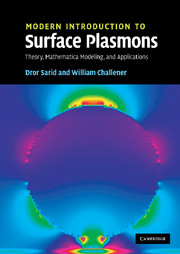Book contents
- Frontmatter
- Contents
- Preface
- 1 Introduction
- 2 Electromagnetics of planar surface waves
- 3 Single-interface modes in the microwave regime
- 4 Single-interface lossless modes in єr′—μr′ parameter space
- 5 Double-interface lossless modes in єr′—μr′ parameter space
- 6 Single-interface surface plasmons
- 7 Double-interface surface plasmons in symmetric guides
- 8 Quasi-one-dimensional surface plasmons
- 9 Localized surface plasmons
- 10 Techniques for exciting surface plasmons
- 11 Plasmonic materials
- 12 Applications
- Appendix A
- Index
9 - Localized surface plasmons
Published online by Cambridge University Press: 05 May 2013
- Frontmatter
- Contents
- Preface
- 1 Introduction
- 2 Electromagnetics of planar surface waves
- 3 Single-interface modes in the microwave regime
- 4 Single-interface lossless modes in єr′—μr′ parameter space
- 5 Double-interface lossless modes in єr′—μr′ parameter space
- 6 Single-interface surface plasmons
- 7 Double-interface surface plasmons in symmetric guides
- 8 Quasi-one-dimensional surface plasmons
- 9 Localized surface plasmons
- 10 Techniques for exciting surface plasmons
- 11 Plasmonic materials
- 12 Applications
- Appendix A
- Index
Summary
Nanoparticles
Introduction
In Chapters 2 to 8 we considered two-dimensional, planar surfaces that support propagating SP modes, and quasi-one-dimensional surfaces like nanowires or nanogrooves that support both propagating and nonpropagating SP modes. In this chapter we consider the quasi-zero-dimensional surfaces for nanoparticles (NPs) and nanoholes. Obviously these surfaces support only localized SP modes. Nevertheless, the richness of the SP phenomena found in these structures has generated a great deal of interest and is finding applications in a variety of areas. A beautiful microscopic image of silver nanoparticles is shown in Fig. 9.1 (see the color figure in the online supplement at www.cambridge.org/9780521767170). The different sizes and shapes of the particles determine the resonant frequencies of the SP modes, resulting in the wide range of colors.
We begin this chapter by studying spherical NPs. Both near-field and far-field properties can be calculated in several different ways, including the quasistatic approximation, Mie theory and a variety of numerical methods such as finitedifference time-domain (FDTD). Ellipsoidal particles and the lightning-rod effect are studied in the quasistatic approximation. Nanovoids are the complement to NPs and also exhibit localized SP modes. A sum rule is derived which connects resonant SP frequencies of a particle and its complementary void. Nanoshells, nanodisks, nanorods and nanotriangles are a few of the NP shapes that have been synthesized and studied in the literature and their SP properties are considered here.
- Type
- Chapter
- Information
- Modern Introduction to Surface PlasmonsTheory, Mathematica Modeling, and Applications, pp. 201 - 255Publisher: Cambridge University PressPrint publication year: 2010
- 3
- Cited by

